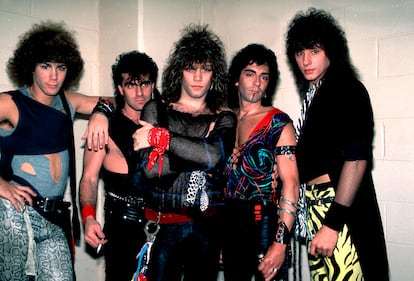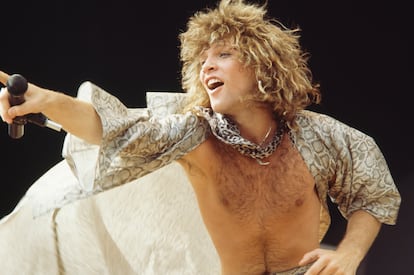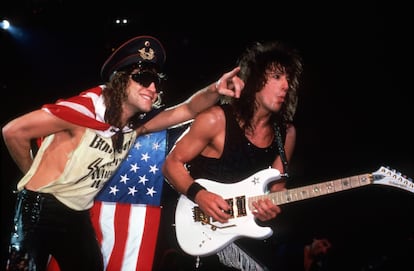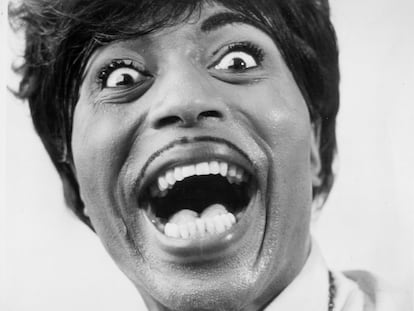Prefabricated? Commercial? Bon Jovi, always questioned, but always on top
This week, the band’s lead singer will be honored as the 2024 Person of the Year, just as their first album turns 40

If there is something that Jon Bon Jovi always wanted, it was to succeed. In a cover story published in Rolling Stone magazine in 1987, Derek Shulman, vice president of Polygram — the record company that signed the band — explains what motivated him to offer the singer a juicy contract: “I felt he had an unbelievable desire to be a star. He had a burning desire to be huge.” The day that Richie Sambora met him, he decided: “This guy is going to be very huge. This is my place.” They were together for 30 years, until the guitarist left the band in 2013.
When Rolling Stone dedicated its coveted cover to Bon Jovi, they had just released their third album, Slippery When Wet (1986), their best-selling up to that moment and still their most popular work today, with classics such as You Give Love a Bad Name and Livin’ on a Prayer. The story goes that in order to choose the songs for the album, Bon Jovi held a gathering with about 100 teenagers, where they played 30 songs they had recorded. Then, they kept the 10 best rated by their guests. In the music industry, Bon Jovi has always stood out as a great strategist, an essential characteristic for those who aim for greatness. Forty years have passed since the New Jersey band’s first record, and they are still there, at the top. The group is currently preparing a new tour, in which Sambora may return. In addition, on February 2, Jon Bon Jovi (alone) will be honored in Los Angeles as the 2024 Person of the Year at the Grammy Awards pre-show (two nights before the main event on Sunday 4). All this with a voice that has become so fragile that some specialists struggle to understand the risks he takes.

“It’s a rare case, indeed,” says César Martín, director of the Spanish rock magazine Popular 1. “His voice has been in bad shape for many years, but not only that: he enters the songs at the wrong time, you can see him suffer on stage. In any case, he has always been more of an entertainer than a professional singer in the vein of Bruce Dickinson or Ronnie James Dio. At first, Jon overcame these vocal shortcomings with the vigor of youth. But not anymore. On the other hand, he has every right to continue performing. And I don’t think he does it for the money, but because he enjoys touring. And he sells out stadiums.”
Jon Bon Jovi’s look is so relevant that many specialists and followers are convinced that his stylistic decisions determined the band’s path, for better and for worse. In the 1980s, his puffy hair was synonymous with good rock songs; then, his haircut coincided with his musical decline. Pablo Mayoral, co-host of the Spanish radio show and podcast Corsarios del metal, says: “In the 1990s, classic heavy metal becomes harder. Judas Priest releases Painkiller and Iron Maiden Fear of the Dark: both very aggressive albums. Within that context, Bon Jovi is out of the game for the heavy metal fan.”
The story of Bon Jovi cannot be told without its rock credentials being questioned at some point. The group began in the 1980s as part of a scene that became known as hair metal or glam metal: musicians with big, bouffant hairstyles, colorful clothing and rock songs adorned with sparkling choruses. Mötley Crüe, Ratt, Poison, Dokken, Quiet Riot… and Bon Jovi. “Bon Jovi’s first four albums (until New Jersey, 1988) are fantastic. And, above all, they had great songs, which is the basis of any genre, it doesn’t matter if you do thrash metal, pop or punk,” says the director of Popular 1. MTV, which was born in 1981, served as a gigantic showcase for these bands, with their videos rotating non-stop. In his book Fargo Rock City, writer Chuck Klosterman defends Bon Jovi: “We may remember Bon Jovi as the safest of all these metal bands and certainly the most stereotypically commercial, but they were real songwriters who simply tugged at heartstrings.”

Jon Bon Jovi loved Van Halen — a more experienced band that all the big-haired boys looked up to — but also Bruce Springsteen. That is where his ambition turned to. “There was a lot of saturation within hair metal. New bad groups began to get in the way of the good ones. In the 1990s, the genre was beginning to become obsolete. Bon Jovi commercialized its sound and lost the heavy metal and rock fans, but it was rewarded with another type of audience. It went mainstream, where all types of audiences fit: these are people that one day go to see U2 and another Madonna or Coldplay or Bon Jovi. It’s about the experience of a massive show, regardless of who’s on stage,” says Mayoral.
Martín recalls that whenever the band was interviewed during the 1990s, they always rejected the hard rock scene, “where they came from.” “It was inevitable to compare them with Gun N’ Roses, who in 1987 published their debut album [Appetite for Destruction] and were a band that projected risk, danger and rock and roll. Bon Jovi clearly came up short,” says the head of Popular 1.
There is some controversy regarding the birth of the group. John Francis Bongiovi Jr., a working-class boy from New Jersey, began working as a teenager in his cousin Tony Bongiovi’s recording studio, the Power Station, in New York City. There he created his first songs, with whatever musicians were around at the moment and with the help of his cousin. The song Runaway came from those sessions. A New York DJ played it and it was a success. That is when the record deal arrived and the band began to take shape. “In that sense I think it’s a prefabricated group. It’s not like Metallica, for example, or other big bands who were friends since they were kids. Here, it is created around Jon Bon Jovi, after having composed the hit Runaway,” continues Mayoral. After the success of this first album, the vocalist’s cousin sued them, claiming that he had contributed considerably to the sound of the album. However, before going to trial, the band reached a financial agreement with Tony Bongiovi.

Jon Bon Jovi has always cultivated a good guy image, participating in numerous charitable causes. During the worst weeks of the pandemic, he went into a restaurant’s kitchen, put on an apron and cooked for days for people without resources. He is a close friend of former U.S. Vice President and Nobel Peace Prize winner Al Gore, and has participated in Democratic Party campaigns in support of Bill and Hillary Clinton, Barack Obama and Joe Biden. “And he has been with the same partner for 40 years [Dorothea Hurley], something absolutely unusual in rock,” notes Martín.
No youthful voice, no big hair, no relevant albums for years. Still, none of that matters if the winner is on stage: thousands of followers will continue to fill the stadiums.
Sign up for our weekly newsletter to get more English-language news coverage from EL PAÍS USA Edition
Tu suscripción se está usando en otro dispositivo
¿Quieres añadir otro usuario a tu suscripción?
Si continúas leyendo en este dispositivo, no se podrá leer en el otro.
FlechaTu suscripción se está usando en otro dispositivo y solo puedes acceder a EL PAÍS desde un dispositivo a la vez.
Si quieres compartir tu cuenta, cambia tu suscripción a la modalidad Premium, así podrás añadir otro usuario. Cada uno accederá con su propia cuenta de email, lo que os permitirá personalizar vuestra experiencia en EL PAÍS.
¿Tienes una suscripción de empresa? Accede aquí para contratar más cuentas.
En el caso de no saber quién está usando tu cuenta, te recomendamos cambiar tu contraseña aquí.
Si decides continuar compartiendo tu cuenta, este mensaje se mostrará en tu dispositivo y en el de la otra persona que está usando tu cuenta de forma indefinida, afectando a tu experiencia de lectura. Puedes consultar aquí los términos y condiciones de la suscripción digital.
More information
Archived In
Últimas noticias
What is known about the Interoceanic Train derailment in Oaxaca
Trump turns a Minnesota fraud allegation into ammunition for his MAGA army against Democrats
The year Trump created 1.6 million undocumented immigrants
Russia threatens to break off negotiations after accusing Ukraine of attacking one of Putin’s residences
Most viewed
- Reinhard Genzel, Nobel laureate in physics: ‘One-minute videos will never give you the truth’
- Oona Chaplin: ‘I told James Cameron that I was living in a treehouse and starting a permaculture project with a friend’
- Pablo Escobar’s hippos: A serious environmental problem, 40 years on
- Chevy Chase, the beloved comedian who was a monster off camera: ‘Not everyone hated him, just the people who’ve worked with him’
- Why we lost the habit of sleeping in two segments and how that changed our sense of time











































